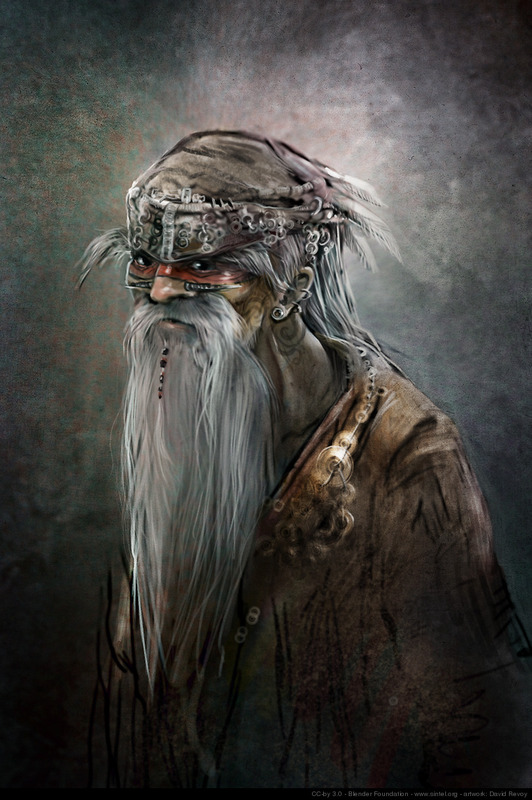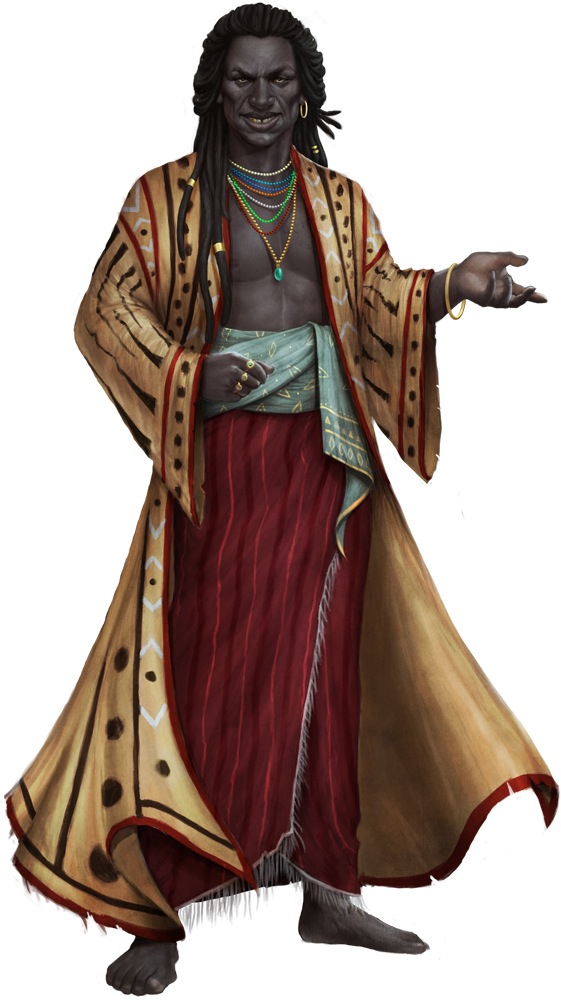You are using an out of date browser. It may not display this or other websites correctly.
You should upgrade or use an alternative browser.
You should upgrade or use an alternative browser.
D&D General GM's Closet for the CONAN RPG
- Thread starter Water Bob
- Start date
HYBORIANS
Mongoose published a good stable of books for us to use in playing the game, but the company did not cover every kingdom known to exist in the world with a supplement. So, what do you do if you want to set your adventures in Nemdia, or Corintha, or Ophir, or any of the other Hyborian nations that don't have a sourcebook to explain to you the eccentricities of the people who will come into contact with your player characters?
You do it the old fashioned way. You take what resources you have and make do with what you have. You use your own knowledge and creativity to fill in the details and make your version of Hyperborea or Brythunia a memorable place in which to adventure.
For ideas, the first place that you'll want to look is the Howard stories. Are there any Conan stories that Howard wrote set in the kingdom where you will play?
Howard did not flesh out many places in Conan's world, so if you strike out there, then expand your search. Go to the pastiches. Check to see if you have access, or can obtain, a Conan story not written by Howard, set where you need it. Check the novels and the comics and games and the internet. You can find loads of information on a place like, say, Nemedia. You can read stories set there, visually see the place through comics, and learn details on websites dedicated to Conan.
FROM A MONGOOSE PERSPECTIVE
From a pure RPG perspective, use the sourcebook for Aquilonia as your base guide on Hyborians. But, notice the differences made to the Hyborian peoples of Argos and Zingara shown in that sourcebook. With those two books as your base, read the entry for the kingdom that you want to play in Return To The Road of Kings.
Use those three sources to extrapolate what the various places are like--the Hyborian kingdoms that you want to develop.
And, don't forget to look to Conan RPG adventures that may be set in the kingdom of your focus. Those may have some information that will guide you as you assemble your own notes on the Hyborian kingdom in which you want to play.
Mongoose published a good stable of books for us to use in playing the game, but the company did not cover every kingdom known to exist in the world with a supplement. So, what do you do if you want to set your adventures in Nemdia, or Corintha, or Ophir, or any of the other Hyborian nations that don't have a sourcebook to explain to you the eccentricities of the people who will come into contact with your player characters?
You do it the old fashioned way. You take what resources you have and make do with what you have. You use your own knowledge and creativity to fill in the details and make your version of Hyperborea or Brythunia a memorable place in which to adventure.
For ideas, the first place that you'll want to look is the Howard stories. Are there any Conan stories that Howard wrote set in the kingdom where you will play?
Howard did not flesh out many places in Conan's world, so if you strike out there, then expand your search. Go to the pastiches. Check to see if you have access, or can obtain, a Conan story not written by Howard, set where you need it. Check the novels and the comics and games and the internet. You can find loads of information on a place like, say, Nemedia. You can read stories set there, visually see the place through comics, and learn details on websites dedicated to Conan.
FROM A MONGOOSE PERSPECTIVE
From a pure RPG perspective, use the sourcebook for Aquilonia as your base guide on Hyborians. But, notice the differences made to the Hyborian peoples of Argos and Zingara shown in that sourcebook. With those two books as your base, read the entry for the kingdom that you want to play in Return To The Road of Kings.
Use those three sources to extrapolate what the various places are like--the Hyborian kingdoms that you want to develop.
And, don't forget to look to Conan RPG adventures that may be set in the kingdom of your focus. Those may have some information that will guide you as you assemble your own notes on the Hyborian kingdom in which you want to play.
HYBORIAN AGE = POOR AGE
The Hyborian Age is not a time of riches. Character should not be able to get rich by adventuring. Monsters do not sit on piles of gold as do dragons in a D&D game. Think of the Conan stories. Conan has gone on many adventures. He has explored several ancient ruins, and he's faced all sorts of demons and monsters. But what wealth has he gained from this? Hardly none.
Remember this when creating your Hyborian Age adventures. You've got to remove the D&D-ish adventuring rewards of better equipment and mounds of loot from your thinking. That's not what adventuring during the Hyborian Age is all about--although it can be used as a good hook to lure the PCs to a specific adventure.
Don't share this thought with your players. If you do, the PCs will never be enticed to venture into an old ancient ruin in search of untold riches. Remember, in the stories, Conan was often lured by the promise of wealth. He just never found any lasting wealth.
And, remember the High Living rule from the core rulebook. Again, this is not something that you'll want to share with your players. Don't take away their dreams of loot. But, use the guideline to structure your games so that wealth, when obtained, seems to drip through their fingers.
Wealth, during the Hyborian Age, is more akin to that of the Dark Ages. Most people simply do not have a lot of wealth. Remember this if your characters are thieves and break into homes.
PAGE 135 of the D&D 3.5 DMG
If you have the DMG, then look on page 135. There, you will see a gauge to use to estimate how wealthy an average character should be, according to his character level.
Of course, this is just a very vague rule of thumb. Create your NPCs according to your story. But, if you want a generic method of gauging wealth, then you can use this. I have lowered the numbers below to fit more closely with a Conan game. This can be useful when figuring how much wealth a PC might find on a downed foe when stripping bodies.
When using the DMG Table 5-1 as a gauge, consider the number to represents silver pieces, of course. A Conan character should have about 1/100th of that number in actual wealth. Thus, a 1st level character will have 1d6 - 1 sp, as noted in the core rulebook. A 4th level character will have, according to the chart, a maximum of 54 sp. This should be a range of 0-54 sp. Roll that randomly however make sense to you. For example, you can roll 2d20 + 1d10 + 1d4 sp. That will generate an amount of wealth for a 4th level character to be 4-54 sp, which sounds just about right to me (given the prices of items in the game). Minimum sp should not be higher than the character's level.
Remember that the wealth of a character does not have to be in coin. This wealth number covers any rings, earrings, bracelets or armlets, necklaces, piercing, and any other kind of wealth the character may have. If you have a 4th level NPC, and you roll that he has 27 sp in wealth, then it is most interesting if you get creative and detail the character something like this: 14 silver lamus (the local coin currency), a painted wood bead necklace worth 3 sp, and a bronze lucky charm in the shape of a carved frog, about the size of a bottle cap, that he keeps in his pocket, worth 10 sp.
BASE ITEM PRICE: Also remember that the prices of items listed in the game are base prices. Items are priced for the base, no frills version of that item. Look to the description of prices in the core rulebook. There are three categories for item prices: Base Quality, Merchant Quality, and Noble Quality. Base prices are that listed in the game. Merchant Quality prices are base price multiplied by 5-20 times. Noble Quality prices are base price multiplied by 50-100 times, where as the highest nobles, such as kings, use a quality that is at least 100 times base price.
Remember this pricing rule when characters in your game are shopping the bazaar for equipment. For example, a weapon-master's stall may have three swords for sale:
A base, no frills, short sword worth 50 sp.
A cutlass with alligator-leather grip, chromed blade decorated with script, worth 800 sp (base price is 50 sp).
A scimitar with a ruby encrusted hilt, delicate engraved decoration, chromed blade, with matching shagreen scabbard, worth 5,600 sp (base price 75 sp).
CHARACTER EQUIPMENT
You can also use the chart in the DMG to gauge the quality of equipment the character is carrying. Consider the base budget for equipment (based on character class) given in the core rule book. The chart in the DMG gives you a bigger budget with which to equip the character. This reflect the adventuring and wealth the character has obtained during his travels. The character may not have more equipment. Instead, he may just have more expensive equipment.
As an example, a character may have a leather jerkin, but it may look like this:
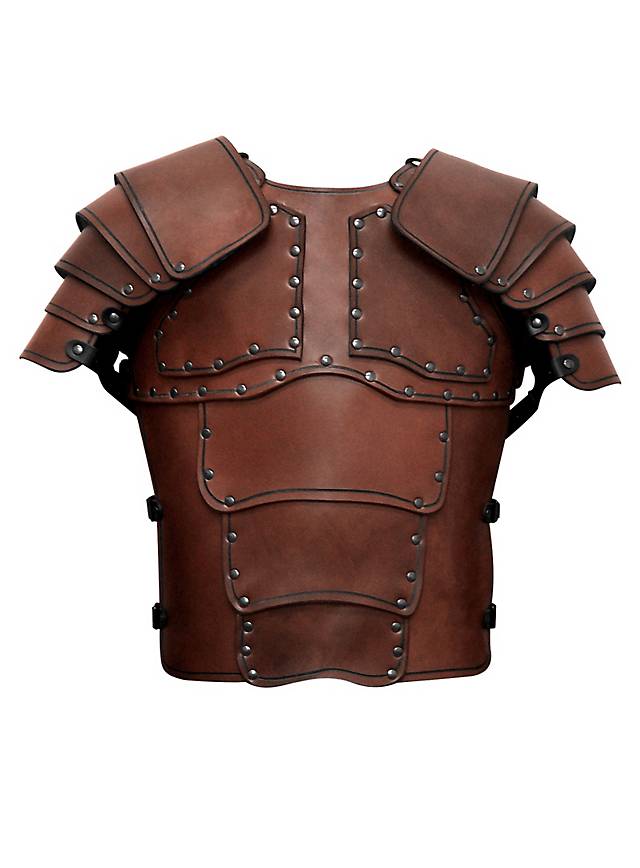
Or, it may look like this:
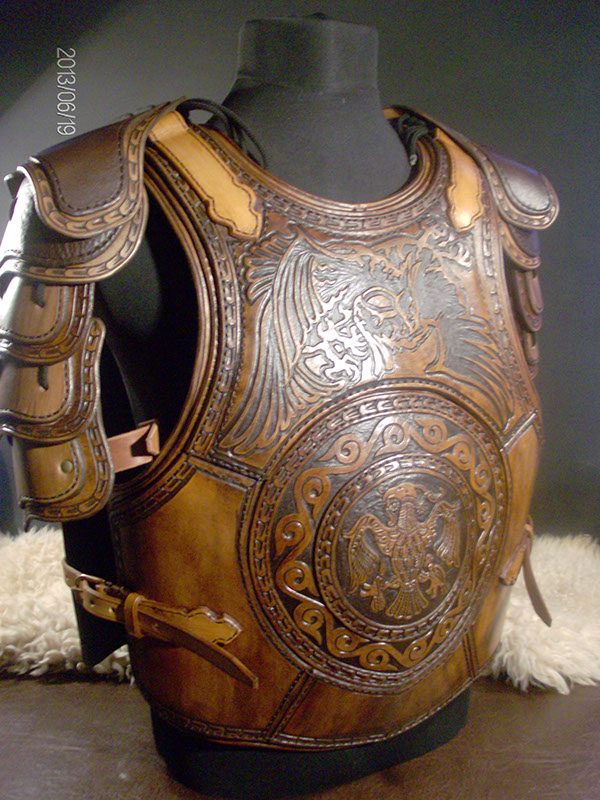
Or, it may look like this:

When using the DMG chart as a guide, consider that the character has the appropriate base budget for equipment, as given in the core rulebook, but increase it by an amount equal to 10% of the amount shown in the DMG, in silver pieces. So, a 2nd level character would have the base equipment budget plus 90 sp. A 5th level character would increase his base equipment budget by 900 sp.
This will allow you to bring things into the game that the PCs may want (once they strip the bodies). And, it will give you an idea of what the item will sell for used. Remember, though, that the core rulebook tells us that used items sell for, at most, 50% of their value (as the re-seller must make a profit and will sell a used item for less than what a new item will bring at market).
Now, if the used item is extremely used, bloody, dirty, damaged, and just not new, then the item will sell, if at all, for something in the range of 0-50% of the new item cost.
When the PCs are selling items, also consider the availability of the item. If a merchant already has five base quality short swords, then he's probably not going to spend his coin on buying a sixth. A used base quality short sword in excellent condition would fetch, at most 25 silvers. But if the short sword is worn and notched, with dried blood in the cracks, the merchant with five of these (all in better condition) may only offer a single silver piece for the sword, if he buys it at all.
The Hyborian Age is not a time of riches. Character should not be able to get rich by adventuring. Monsters do not sit on piles of gold as do dragons in a D&D game. Think of the Conan stories. Conan has gone on many adventures. He has explored several ancient ruins, and he's faced all sorts of demons and monsters. But what wealth has he gained from this? Hardly none.
Remember this when creating your Hyborian Age adventures. You've got to remove the D&D-ish adventuring rewards of better equipment and mounds of loot from your thinking. That's not what adventuring during the Hyborian Age is all about--although it can be used as a good hook to lure the PCs to a specific adventure.
Don't share this thought with your players. If you do, the PCs will never be enticed to venture into an old ancient ruin in search of untold riches. Remember, in the stories, Conan was often lured by the promise of wealth. He just never found any lasting wealth.
And, remember the High Living rule from the core rulebook. Again, this is not something that you'll want to share with your players. Don't take away their dreams of loot. But, use the guideline to structure your games so that wealth, when obtained, seems to drip through their fingers.
Wealth, during the Hyborian Age, is more akin to that of the Dark Ages. Most people simply do not have a lot of wealth. Remember this if your characters are thieves and break into homes.
PAGE 135 of the D&D 3.5 DMG
If you have the DMG, then look on page 135. There, you will see a gauge to use to estimate how wealthy an average character should be, according to his character level.
Of course, this is just a very vague rule of thumb. Create your NPCs according to your story. But, if you want a generic method of gauging wealth, then you can use this. I have lowered the numbers below to fit more closely with a Conan game. This can be useful when figuring how much wealth a PC might find on a downed foe when stripping bodies.
When using the DMG Table 5-1 as a gauge, consider the number to represents silver pieces, of course. A Conan character should have about 1/100th of that number in actual wealth. Thus, a 1st level character will have 1d6 - 1 sp, as noted in the core rulebook. A 4th level character will have, according to the chart, a maximum of 54 sp. This should be a range of 0-54 sp. Roll that randomly however make sense to you. For example, you can roll 2d20 + 1d10 + 1d4 sp. That will generate an amount of wealth for a 4th level character to be 4-54 sp, which sounds just about right to me (given the prices of items in the game). Minimum sp should not be higher than the character's level.
Remember that the wealth of a character does not have to be in coin. This wealth number covers any rings, earrings, bracelets or armlets, necklaces, piercing, and any other kind of wealth the character may have. If you have a 4th level NPC, and you roll that he has 27 sp in wealth, then it is most interesting if you get creative and detail the character something like this: 14 silver lamus (the local coin currency), a painted wood bead necklace worth 3 sp, and a bronze lucky charm in the shape of a carved frog, about the size of a bottle cap, that he keeps in his pocket, worth 10 sp.
BASE ITEM PRICE: Also remember that the prices of items listed in the game are base prices. Items are priced for the base, no frills version of that item. Look to the description of prices in the core rulebook. There are three categories for item prices: Base Quality, Merchant Quality, and Noble Quality. Base prices are that listed in the game. Merchant Quality prices are base price multiplied by 5-20 times. Noble Quality prices are base price multiplied by 50-100 times, where as the highest nobles, such as kings, use a quality that is at least 100 times base price.
Remember this pricing rule when characters in your game are shopping the bazaar for equipment. For example, a weapon-master's stall may have three swords for sale:
A base, no frills, short sword worth 50 sp.
A cutlass with alligator-leather grip, chromed blade decorated with script, worth 800 sp (base price is 50 sp).
A scimitar with a ruby encrusted hilt, delicate engraved decoration, chromed blade, with matching shagreen scabbard, worth 5,600 sp (base price 75 sp).
CHARACTER EQUIPMENT
You can also use the chart in the DMG to gauge the quality of equipment the character is carrying. Consider the base budget for equipment (based on character class) given in the core rule book. The chart in the DMG gives you a bigger budget with which to equip the character. This reflect the adventuring and wealth the character has obtained during his travels. The character may not have more equipment. Instead, he may just have more expensive equipment.
As an example, a character may have a leather jerkin, but it may look like this:

Or, it may look like this:

Or, it may look like this:

When using the DMG chart as a guide, consider that the character has the appropriate base budget for equipment, as given in the core rulebook, but increase it by an amount equal to 10% of the amount shown in the DMG, in silver pieces. So, a 2nd level character would have the base equipment budget plus 90 sp. A 5th level character would increase his base equipment budget by 900 sp.
This will allow you to bring things into the game that the PCs may want (once they strip the bodies). And, it will give you an idea of what the item will sell for used. Remember, though, that the core rulebook tells us that used items sell for, at most, 50% of their value (as the re-seller must make a profit and will sell a used item for less than what a new item will bring at market).
Now, if the used item is extremely used, bloody, dirty, damaged, and just not new, then the item will sell, if at all, for something in the range of 0-50% of the new item cost.
When the PCs are selling items, also consider the availability of the item. If a merchant already has five base quality short swords, then he's probably not going to spend his coin on buying a sixth. A used base quality short sword in excellent condition would fetch, at most 25 silvers. But if the short sword is worn and notched, with dried blood in the cracks, the merchant with five of these (all in better condition) may only offer a single silver piece for the sword, if he buys it at all.
SUGGESTED READING
There are three supplement books that every Conan GM should read: Aquilonia - Flower of the West, Across The Thunder River, and Styiga - Serpent of the South.
These are dense game books packed full of atmosphere and notes that will help make any GM a master at describing the Hyborian Age. If you put the time into reading these three books, cover to cover, you have have the perfect foundation with which to run adventures in any part of the Known World.
The Aquilonia book will give you a good grounding in Hyborian culture. That will be helpful in running games in any of the many Hyborian kingdoms.
The Thunder River book will give you a look at what life will be like for a barbaric culture. Sure, this book focuses on the Picts and the Aquilonian invaders, but in having this information as a background, it will give you a good foundation for running games in Nordheim, Cimmeria, the Black Kingdoms, or any other barbaric culture.
Lastly, the Stygia book will give you a good look at how a major, non-Hyborian setting should be run. Sure, there are a lot of differences in say, Turan, Zamora, and Stygia, but the Stygia book will give you the background that you need to set up your games in Turan and Zamora properly.

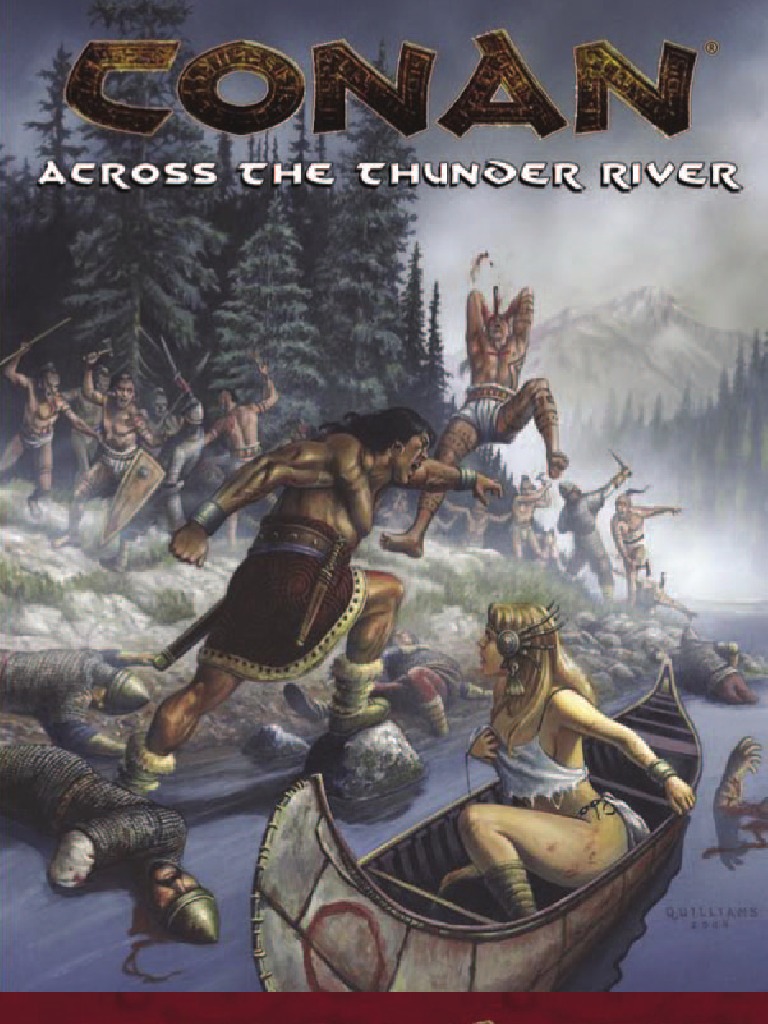

Of course, if you have a specific setting book for where you are setting your game, then you should read that, too. My point here is that a GM can use just the three books above, tempered with what is in Return to the Road of Kings, to set a game anywhere in the Known World during Conan's time.
There are three supplement books that every Conan GM should read: Aquilonia - Flower of the West, Across The Thunder River, and Styiga - Serpent of the South.
These are dense game books packed full of atmosphere and notes that will help make any GM a master at describing the Hyborian Age. If you put the time into reading these three books, cover to cover, you have have the perfect foundation with which to run adventures in any part of the Known World.
The Aquilonia book will give you a good grounding in Hyborian culture. That will be helpful in running games in any of the many Hyborian kingdoms.
The Thunder River book will give you a look at what life will be like for a barbaric culture. Sure, this book focuses on the Picts and the Aquilonian invaders, but in having this information as a background, it will give you a good foundation for running games in Nordheim, Cimmeria, the Black Kingdoms, or any other barbaric culture.
Lastly, the Stygia book will give you a good look at how a major, non-Hyborian setting should be run. Sure, there are a lot of differences in say, Turan, Zamora, and Stygia, but the Stygia book will give you the background that you need to set up your games in Turan and Zamora properly.



Of course, if you have a specific setting book for where you are setting your game, then you should read that, too. My point here is that a GM can use just the three books above, tempered with what is in Return to the Road of Kings, to set a game anywhere in the Known World during Conan's time.
darthgall
Villager
Always like the art suggestions.
Here's one from me:
First, I really like Atlas Obscura, if you're at all interested in offbeat, hidden history, their newsletter is worth a subscription.
But for this game, here's a link to an article about a Witchcraft museum with lots of pictures of the exhibits. Most would make great cursed/sought after items for a Hyborian adventure.
http://www.atlasobscura.com/articles/museum-of-witchcraft-magic-photos
Mick
Here's one from me:
First, I really like Atlas Obscura, if you're at all interested in offbeat, hidden history, their newsletter is worth a subscription.
But for this game, here's a link to an article about a Witchcraft museum with lots of pictures of the exhibits. Most would make great cursed/sought after items for a Hyborian adventure.
http://www.atlasobscura.com/articles/museum-of-witchcraft-magic-photos
Mick
Similar Threads
- Replies
- 96
- Views
- 28K
- Replies
- 73
- Views
- 11K
D&D 5E (2024)
2024 D&D Starter Set - Your turn to design
- Replies
- 27
- Views
- 2K
- Replies
- 53
- Views
- 16K
Enchanted Trinkets Complete
Recent & Upcoming Releases
-
December 9 2025 -
June 18 2026 -
October 1 2026

